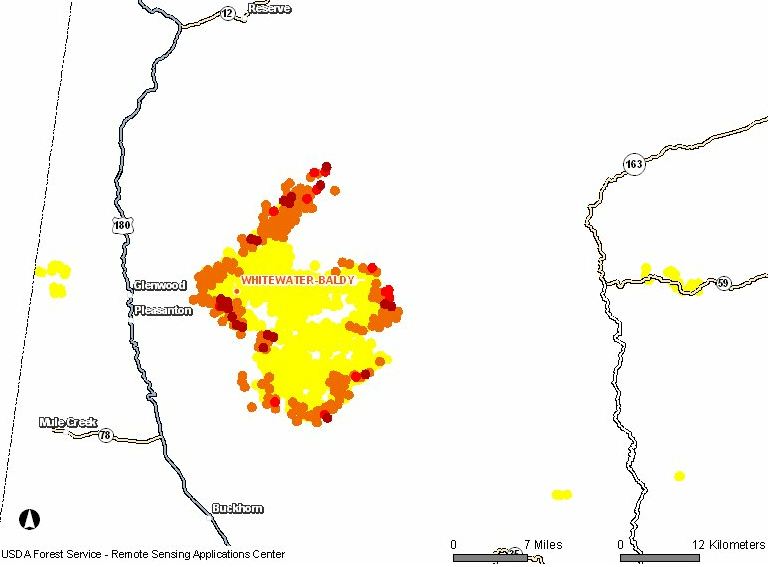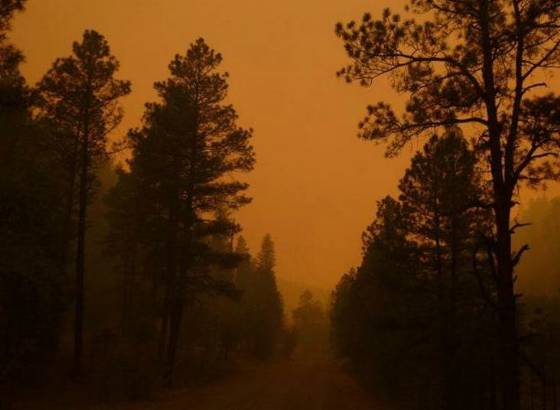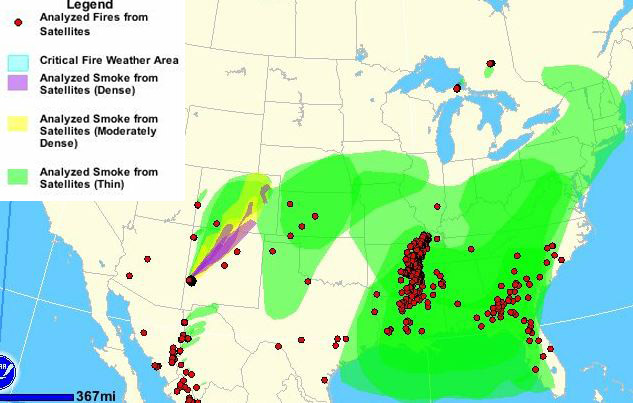
The Whitewater-Baldy fire on Saturday, pushed by strong southwest winds gusting up to 37 mph, added another 40,000 acres and ran 12 miles beyond Highway 159 toward the northeast as far as Reserve-Beaverhead Road. The fire has now blackened a total of 122,000 acres, but that may pale in comparison to the ultimate size of this monster fire. The Incident Management Team has planned a fireline which would triple its size to over 360,000 acres. The Team apparently concluded that this may be the only viable alternative. The fire continually outflanks the shorthanded firefighters, with the rapid rate of spread exceeding their capabilities to construct effective fireline.
Massive burnout operations from indirect firelines miles from the main fire are not unprecedented on major fires. In recent memory they have been used, mostly successfully, on fires on the Los Padres National Forest in southern California, including the Basin Complex, Indians, Iron Alps, and Zaca fires. Bill Molumby who was Incident Commander of a Type 1 Incident Management Team during phases of these fires, successfully directed (along with others) huge burnouts that ultimately stopped the spread of the fires after they had burned for weeks or months. But implementing large, risky plans like these require the best of the best — highly skilled and experienced Incident Commanders, Operations Section Chiefs, Division Supervisors, and firefighters on the ground. They can take weeks or months to complete, and we hope that the necessary personnel, equipment, and firefighters can be found that can safely execute such an ambitious plan. Maybe Bill Molumby, or someone else equally skilled, can be brought out of retirement to assist during the next several weeks or months.
And there is always the chance that the weather will change and mother nature will put out the fire.

So far the relatively small force of 586 personnel, 26 Engines, 2 Dozers, 4 helicopters, and 2 air tankers has been largely ineffective in suppressing the fire. As we noted on Saturday, the number of resources assigned to this 122,000-acre fire is much less than was on the 4,100-acre Banner fire earlier this week which had 73 engines, 2 dozers, 6 air tankers, 7 helicopters, 47 hand crews, and 965 personnel. Thanks to the aggressive initial attack and favorable weather, the Banner fire is expected to be fully contained on Monday. But the degree of difficulty facing the firefighters on the Whitewater-Banner fire is real, with rough country, and powerful winds.
Smoke from the fire is having a significant impact over much of the United States, as you can see from the map below. Some residents of Colorado are detecting a strong odor of smoke and are assuming that there is a nearby fire, but depending on their location, it is most likely coming from the Whitewater-Baldy fire in western New Mexico.
Dense and very visible smoke is drifting into the Albuquerque area, 150 miles northeast of the fire, as seen in this video.

On Saturday the fire spread to within 2.6 miles of Mogollon, which is frequently described as a ghost town, but has structures listed on the National Register of Historic Places.

The analogy you write of Bill, brings a smile to my face. No truer words. Good to see you out lurking around, watching….. Dozer Don CIIMT 5
I appreciate the confidence place in CIIMT 2’s ability (based on our former success’), but truth be told, while fire still behaves and reacts to as it did for the last 1000 years, the political climate has changed and has now hamstrung IMT’s decision making. Fortunatly on the Zaca Fire we had the backing of the govenor and public (but perhaps not the forest service) in conducting such a large scale burnout. Regardless, decision making for a IC these days is a precarious trip, traveling at high speed down a narrow one lane mountain road with a sheer cliff on one side and cut bank on the other, the back seat filled with various sorts bent on deciding how you will negotiate you trip. Enough of that, I boast of the Lincoln Complex where limited resources allowed us to do our best firefighting (and backfiring). Prayers of safety to all on the line this season.
Cheers…
Thanks Johnny, always nice to hear from someone who knows what they are talking about…from a novice perspective my sadness and fear rule and my thoughts are to put everything on pour fire and put it out…thats prob why the educated people are in charge up there 🙂
Air tankers are most valuable when used to stop a new fire. A lightning strike, match head flame, spark from a grinder are some examples that one very small unit of fire starts all fires. It is amazing that some of these starts will escalate into major disasters. It is here within the first few minutes of a wildfire that fixed-wing air tankers have center stage. When fires are allowed to escape and acreages increase the role of the fixed-wing tanker decreases. As for the Whitewater-Baldy this is a big ugly fire. If strenghting a line or supporting a burnout or backfire operation requires air support it could come in the form of a fixed wing or helicopter. There are not enough fixed wing tankers available in the U.S. to build line with retardant (slurry) on a fire this size. Because of terrain and weather which could place personnel in harms way it is better to back off; work the fire on your terms, don’t let the fire work you!
I just want to know why on earth are there no slurry drops on this fire? Seems like tjere would be some on a fire this large!
There seems to be an overstaing of the future impacts about the Montana fire trial jury decision. When the decision-making process and the actions taken are well thought out and documented, I believe that no one will find fault with the use of backfiring and burnout operations for wildfire suppression. But that all said, shoot from the hip and you might get shot in the foot.
Bill
Sorry… I was challenged and should have found a better way of putting it
I know now, to just back down and let everyone else be the expert
Thanks..
You took the bait that was shamelessly put out there.
Fishing season is now closed.
*sigh*
Since that crap has now been settled, we will return to our regularly scheduled programming, wildland fires.
Additional similar comments will be deleted.
Aircraft Mechanic / Turbine Engine Mechanic / Aircraft Technical InspectorEdit
US Army Reserve / US Army Natl Guard
September 1982– May 2004 (21 years 9 months)USARNG AASF Hangar ST Paul, MN
Retired SSG (E6) from E CO 2 /147 Avn CO MN ARNG holding Master Aircrewmember status and holding 68B, 67N, 67Y, and 15T MOS series. Served as Shop TI during last 6 years of service and also held ALSE and Safety NCO positions in the unit.
Aviation Support to Task Force 364 Miami, FL for the purpose of 1987 through 1990 road building exercise with aviation support at Palmerola AB, Teguchigulpa, Honduras, CA in support of Honduran locals and US Army Engineers. Aviation support consisted of maintenance, personnel, and lift missions to support all facets of road building (USARES)
Basic NCO Course (BNCOC) 88th USARCOM Ft Snelling, MN
Advanced NCO Course (ANCOC) Ft Jackson, SC
Turbine Engine Repair Course 68B
US Army Airborne Life Support Course (ALSE) Ft McCoy WI
UH1 Crew Chief Course 67N
General Electric GE T700 / CT 7 Field Maintenance Course
US Army Safety and Accident Prevention Course
UH60 Blackhawk Transition Course 15T
Engines serviced at AVUM / AVIM / Depot approval:
Pratt & Whitney PT6 series General Electric T700 / CT7 series
Avco Lycoming (Honeywell) T53L13B
Avco Lycoming (Honeywell) T53L 703
Avco Lycoming (Honeywell) T55L 711 / 712
Allison / Rolls Royce 250 series C20/C30
IH Solar/ Sundstrand APU’s
Winter Aircrew Survival School BSA Camp Okpik Ely, MN (USARES)
Dual Status position held in the Army National Guard system for the last 4 of 21 yrs 9 month requiring membership in the National Guard in order to hold Full Time position under USC Title 32.
So as far as aviation coupled with my Forestry degree with a minor in Fire and Avn Management……
I got a slight leg to stand upon
Tim
To start I was never a DIVS I was a HERO, TOLC, HECM, HEMG(T). FFTR 2, Agency Rep , THSP, ENGB ENOP etc ATBM (T)
Did some S234 stuff for awhile
Did some FIREWISE for a coupla yrs
FAA COMM/ Multi/ Tail dragger endorsed/ A&P and ADX, Aircraft Dispatcher
Pilot
Skydive Center
2005– 2007 (2 years)Crete, NE
Performed and ensured aircraft was ready for daily flight through thorough preflight inspection for the safe lift and release of skydivers and their instructors.
Perfomed manifest with DZ manifest people and conducted daily and each weight and balance to ensure aircraft was safe and not approaching over gross weight configurations.
Performed each fueling operation.
When not flying, performed duties that some pilots find beneath them….vacuumming parachute packing carpets and actually cleaning the nasty toilets and keeping hangar facilities clean
Hang on…. more coming
Tim
With the winds and WX lately on the slopes and ridgetops…50-60 mph at times…Seriously???
Well it MIGHT be the one of the tools and toolbox.
Once again, risk vs reward….
Yep, there are lawyers licking their chops waiting for the stupid move. Try aviation and TELL us how many lawyers there are…we kindly advise you wildland firefighters …we have had to contend with this for years….ever see the price of a GA (Cessna type) aircraft? How many lawyers you think jacked up a traditionall 60K to 100K airplane to approx 450K these days?
Careful with your fusees, driptorches, and Verry type pistols
I am sure they are well informed of the precedent setting outcome in MT. This case, while bad in respects, makes one more mindful about settting more fire.
Mother nature and the WX are NOT always on the firefighters side!!
Leo,
I didn’t say do it today, but if an opportunity presents itself, the IMT should take it… if they feel it stands a chance of improving the situation.
Your response appears to presume we lowly “firefighters” don’t know anything about aviation. I’ve IA’d hundreds of fires as a smokejumper and rappeller, how about you? I used to be a helicopter manager and rappel spotter, and I still work in aviation management today. I have also been a Division/Group for over 15 years. Care to share your fire and aviation quals?
You seem to be missing the key point here, which is that the people who have to make these critical decisions about large-scale firing operations do not always get to do it under ideal circumstances. And they shouldn’t have to worry about getting sued for making one of these decisions if it has a bad outcome.
You were right about one thing; Mother Nature and WX don’t always cooperate. Sometimes you have to roll the dice today, because tomorrow’s conditions may be even worse than today’s. Don’t you think those decisions should be left up to firefighters instead of lawyers?
Not trying to be a jerk Tim, but the fact that you rode in an aircraft to lots of fires doesn’t make you an aviation expert any more than hitching a ride on a semi would make you an expert on the trucking industry. Further, a public forum like this is a lame place to be getting in a pissing match over “aviation quals.” Chill out man.
I wonder how many of the Ops Chiefs and DIVS on this fire are aware of the recent precedent-setting Montana judgment in which operations personnel were found to be “reckless” for attempting to do what it appears this IMT is getting ready to do; fire off large amounts of acreage well outside the current fire perimeter. I hope they all have liability insurance.
This is why the Montana case is such a bad deal for firefighters; we should not have to worry about getting sued for using one of the tools in our toolbox. In this case, it may be the only tool that has a reasonable chance of success. The lawyers must be licking their chops right now in anticipation of fat judgments to come.
Many thoughts come to mind as I watch this new destructive fire destroy public lands. Responsible stewardship, a stimulus fire, lack of an effective initial attack program. The Federal goverment is bullet prove. The public,press and politicians (3P’s) are of little assistance. As for air tankers, days too late too big. What would happen if everyone and all mechanical resources on the fire were released? Tens of million dollars in savings and no would gets hurt. Fire size around July 15th (when the rains return) about the same.
New data on Google Earth during the last hour or so….many more hot spots heading toward Elk Mountain, past Lilly Mountain to the east, fringe to the southeast appears to be gaining strength. Winds may have picked up. Has grown on the western side, too.
I should have added to my comment that if anyone knows of any air tankers working this fire, please post here. There have been 0 tankers flying out of Silver. Thanks.
To my knowledge, there have been 0 air tankers working this fire.
I believe when they said that there was 2 air tankers they were actually referring to the two Heli-Tankers that have been flying out of silver city, there are no air tankers working this fire at this time